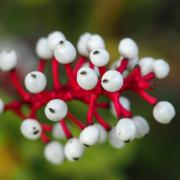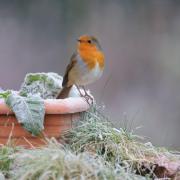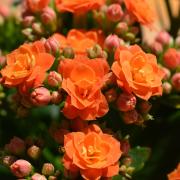Giant beetles, funky-looking caterpillars and huge hoverflies may all be lurking.
We should all be welcoming insects into our garden, pollinating our plants, keeping the food chain going and boosting biodiversity.
There are thought to be as many as 22,400 species of insect across the UK with fewer than 1% of this total considered problematic by gardeners, although some might make you do a second take.
In the run-up to Insect Week, which celebrates insects in all their forms and spreads the message of their important role in maintaining a healthy garden ecosystem, RHS entomologist Josie Stuart selects five fantastic beasts you may see in your garden.
Thick-legged flower beetle (Oedemera nobilis)
One glance at the males and you can see where the name comes from – their legs have a very muscular appearance. Often seen on larger open flowers such as oxeye daisies on warm sunny days, these stunning, metallic green beetles are superb pollinators owing to their prolific feeding on nectar and pollen. You can spot them flitting from flower to flower from April to September.

Lobster moth (Stauropus fagi)
This moth gets its name from its funky-looking caterpillar. The red, lumpy body shape resembles a crustacean and is probably intended as a deterrent to predators. If disturbed, the caterpillar will put on a menacing display to match its faux-spines, rearing up on to its hind legs and throwing its head back.
Strange habits: When first hatched, the caterpillar of the moth feeds entirely on its own eggshell before nibbling on a range of deciduous trees such as birch, hazel and oak. After turning into the rather less spectacular looking fluffy brown moth, it will set about pollinating plants, mating and serving as a delicacy for larger garden visitors.

Cockchafer beetle (Melolontha melolontha)
Perhaps one of the clumsiest insects to be spotted in gardens in late spring and early summer, the cockchafer grows to 50mm in length, making a whirring noise when in flight and can be forgiven for seeming to struggle to stay up. Its rusty brown body, pointed rear and fan-like antennae mean it is unmistakable. It frequently flies towards light sources such as street lights and open windows in urban areas, and although this may be alarming, the beetle is totally harmless.
Strange habits: The larvae live underground for more than two years, feeding on grass roots, and their chunky bodies provide a great source of food for birds, badgers and other wildlife. Once they emerge as adults to commence their brief and uncoordinated flight period, they live for five to six weeks, until early July.

Hornet mimic hoverfly (Volucella zonaria)
This is the UK’s largest species of hoverfly which is an insect often seen winged at flowers. Its excellent mimicry of a hornet is used as a protection against predators as it searches for nectar. Although it may look alarming, it is harmless to humans. Differentiating it from the hornet is its larger body, broader eyes and lack of sting.
Strange habits: It is capable of buzz pollination, a method used by some bee species, where it dislodges pollen by causing the anthers of the flower to vibrate. This makes the hoverfly helpful for fruit set of certain plants such as tomatoes. Its larvae live inside the nests of bees, wasps and hornets as ‘commensals’ – an interaction whereby one species benefits from a situation while the other species neither benefits or is disadvantaged.

Hairy shieldbug (Dolycoris baccarum)
Known as the hairy shieldbug because it appears fuzzier than its shieldbug cousins, it has beautiful purple and green colours in the summer, turning to a duller and more camouflaged brown in the winter but retaining black and white stripy antennae and body edges.
Strange habits: When threatened, shieldbugs can excrete a foul-smelling liquid that also gives them the name stink bugs. Its other common name is the sloe bug, and it sips sap from blackthorn and other related plants, but not enough to have any noticeable effect. Shieldbugs are prized in gardens for their eye-catching beauty.
Insect Week runs from June 24-30. For more on insects in gardens and how you can support them visit the RHS website.


























